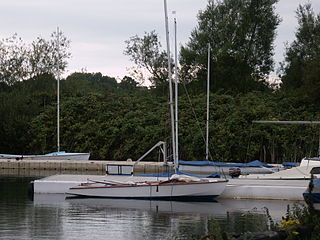
Yachting refers to the use of recreational boats and ships called yachts for sporting purposes. Yachts are distinguished from working ships mainly by their leisure purpose.

Dinghy sailing is the activity of sailing small boats by using five essential controls:

Dinghy racing is a competitive sport using dinghies, which are small boats which may be rowboats, have an outboard motor, or be sailing dinghies. Dinghy racing has affected aspects of the modern sailing dinghy, including hull design, sail materials and sailplan, and techniques such as planing and trapezing.

The Enterprise is a two-man sloop-rigged hiking sailing dinghy with distinctive blue sails. Despite being one of the older classes of dinghies, it remains popular in the United Kingdom and about a dozen other countries, and is used for both cruising and racing. It has a combination of size, weight, and power which appeals to all ages, and to sailing schools. The Enterprise is accredited as an International Class by the International Sailing Federation, the ISAF.

The International Laser Class sailboat, also called Laser Standard and the Laser One is a popular one-design class of small sailing dinghy. According to the Laser Class Rules the boat may be sailed by either one or two people, though it is rarely sailed by two. The design, by Bruce Kirby, emphasizes simplicity and performance. The dinghy is manufactured by independent companies in different parts of the world, including LaserPerformance, Performance Sailcraft Australia (Oceania) and Performance Sailcraft Japan.

The Optimist is a small, single-handed sailing dinghy intended for use by children up to the age of 15. Contemporary boats are usually made of fibreglass, although wooden boats are still built.
Jack Holt, OBE (1912–1995) was a prolific designer of sailing dinghies. His pioneering designs of dinghies using plywood did much to popularise the sport of sailing in the period immediately following World War II.
Sabre, Sabres, or saber may refer to:

The Laser 2 is a double-handed version of the popular Laser one-design class of small sailing dinghy. It is a quick, planing dinghy that differs from the Laser in that it has a jib, symmetric spinnaker and a
trapeze for the crew. It was designed by New Zealander Frank Bethwaite and was first launched as a product in Australia then North America in 1979 and in Europe in 1980. The hull is made of GRP. The rig is a Bermudian rig sloop with spinnaker. It is designed to be a mid to high performance racer. In Britain, its most common current use is at university class in British University Sailing Association (BUSA) events. A version known as the Laser Fun was available, the same hull but featuring a reefable mainsail and a roller furling jib, and with the option of an asymmetric spinnaker. As a strict one-design boat the Laser 2 was not available for amateur construction.

The Lark is a two-person, non-trapeze sailing dinghy, designed in 1966 by Michael Jackson. All Larks are made of glass-reinforced plastic (GRP). The Lark is a one-design class which leads to very close racing.

The Merlin Rocket is a 14 foot dinghy sailed in the United Kingdom. It is an active class, now with over 3700 boats built.

British moth is the name of an 11-foot (3.4 m) sailing dinghy designed in 1932 by Sydney Cheverton.

The Minto Sailing Dinghy is a sailing dinghy first produced commercially in the early 1960 and still in production.
Ian Douglas Ben Proctor, known as Ian Proctor, was a British designer of boats, both sailing dinghies and cruisers. He had more than one hundred designs to his credit, from which an estimate of at least 65,000 boats were built. His pioneering aluminium mast designs also revolutionised the sport of sailing.
Phil Morrison is a British boat designer and racer rendered notable by the success of his many designs in many classes since 1967 as well as his own distinguished yacht racing career.
Jon Turner is a British yachtsman and boat builder. Turner has won national or world championships in International 14, Fireball, Merlin Rocket and Scorpion class racing dinghies.
The Miracle is a small dinghy sailboat popularized in the United Kingdom, and designed by Jack Holt — one of the last for the well-known designer. Holt brought sailing to the masses in the 1960s with his famous Mirror dinghy, and continued to produce designs such as the Enterprise, GP14, Cadet, Hornet, Pacer, Solo, and Streaker — many of which went on to become hugely successful dinghy classes.

The term Salcombe Yawl refers to a small sailing dinghy restricted class native to Salcombe in South Devon, and also to the traditional sailing vessel from the area upon which that class was based, with a 200-year history. The current class of vessel has about the size of a Merlin Rocket, that is 4.88 metres (16.0 ft) and about 180 have been built of which 80% are still in use. It is built traditionally by hand from mahogany, and is clinker built. The centre plate is cast iron, but more recent Yawls have bronze plates. While it is rigged as a ketch with the mizzen ahead of the rudder post, the label yawl is probably derived from a corruption of the word yole, meaning a small inshore fishing boat. Designers, work within the class restrictions, adding innovations to each vessel. It is raced in two classes depending on the age of the boat. A newly built boat in 2009 would cost £40,000 while a second hand vessel would be half of that. There is a glassfibre derivative with aluminium spars called a Devon Yawl. The mould for this was taken from a 1968 Salcombe Yawl and because of the nature of its construction is a one-design. There are approximately 300 Devon Yawls and they are built both in the UK and USA.

The Skua Sailing Dinghy is a keel assisted two-person racing sailboat, broadly similar to the Flying Fifteen in layout and planned use. It was however designed for simple and inexpensive home construction from 6mm Marine plywood.

The Topaz Vibe is a British sailing dinghy designed by Ian Howlett and Rob White. Built by Topper International, it was first introduced in 2006. There are two models, the Vibe and the Vibe X, with the latter carrying larger sails. The Vibe is a World Sailing Learn to Sail class.















